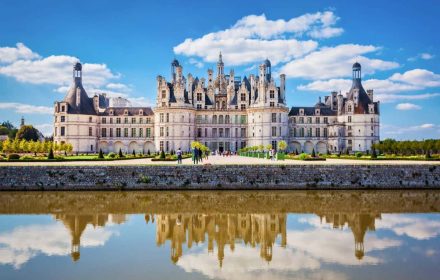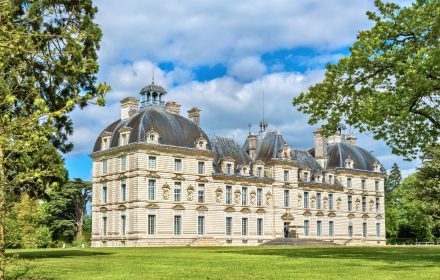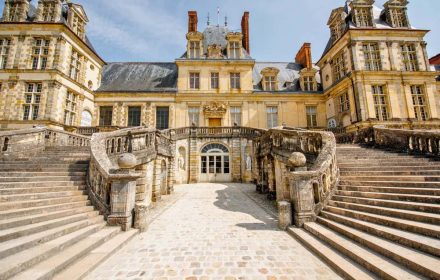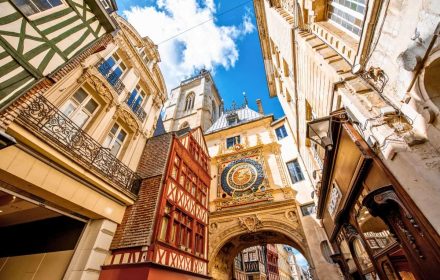This site uses affiliate links, meaning that if you make a purchase through our links, we may earn an affiliate commission.
If you’re exploring the Loire Valley and want to see something a little different from the usual grand château experience, Chaumont-sur-Loire is a great pick. It’s got the fairy-tale looks—turrets, river views, and all that—but what makes it stand out is how it blends art, nature, and history in a way that feels really fresh and unexpected.
So, what to see at Château de Chaumont-sur-Loire? Start with the castle itself—full of charm, with a mix of medieval and Renaissance style. Then there’s the real highlight: the International Garden Festival, which takes over the grounds every year with bold, creative, and often surprising garden designs.
You’ll also find contemporary art installations scattered around the estate, peaceful parkland to wander through, and some seriously stunning views over the Loire River.
This place has personality. It’s beautiful, yes, but also imaginative, inspiring, and just plain fun to explore.
- 1. Brief History of Château de Chaumont-sure-Loire
- 2. What to See at Château de Chaumont-sur-Loire
-
- 2.1. The Architecture of Château de Chaumont-sur-Loire
- 2.2. The Ruggieri Room
- 2.3. The Catherine de Medici Room
- 2.4. The Council Chamber
- 2.5. The Guard Room
- 2.6. The King's Room
- 2.7. The Spiral Grand Staircase
- 2.8. The Chapel
- 2.9. The Private Apartments
- 2.10. Chaumont's Grounds
- 2.11. The Stables at Chaumont
- 2.12. International Garden Festival
- 3. Practical Tips for Visiting Château de Chaumont-sur-Loire
Brief History of Château de Chaumont-sure-Loire
Château de Chaumont-sur-Loire has been sitting high above the river for over a thousand years, and it’s seen a lot. It started off as a fortress around the year 1000, built to keep watch over the border between rival territories.
For centuries, it was owned by the powerful Amboise family, until King Louis XI had it destroyed in the 1400s as payback for a rebellion. But it didn’t stay in ruins for long—the family rebuilt it with a mix of medieval and early Renaissance flair, and that’s when it really started to look like the château we see today.
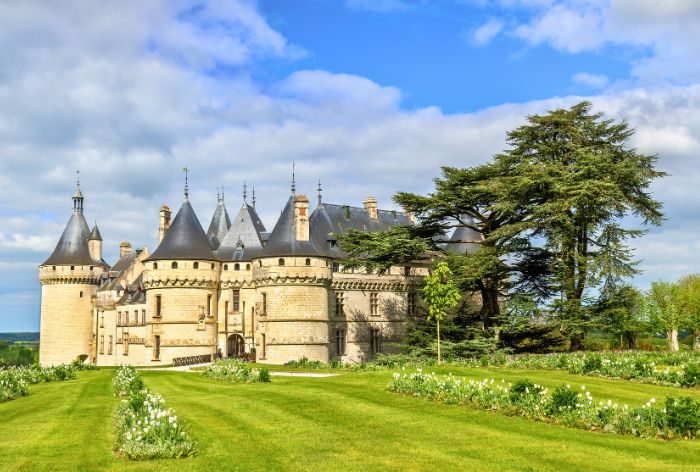
Château de Chaumont-sur-Loire / What to See at Château de Chaumont-sur-Loire
One of the most famous chapters in its history came in the 1500s, when Catherine de’ Medici took over the place.
Yes, that Catherine! She brought her astrologers (including Nostradamus!) and made the château a bit of a mystical hangout. Later, she forced Diane de Poitiers—her late husband’s mistress—to trade Château de Chenonceau for Chaumont.
Let’s just say Diane wasn’t thrilled with the swap and didn’t stick around long.
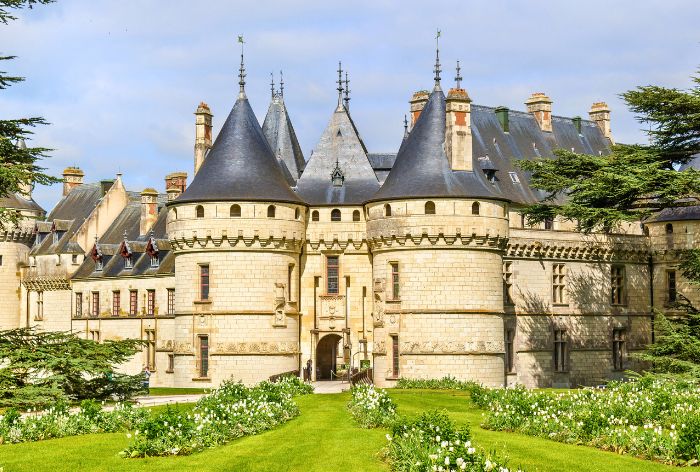
Château de Chaumont-sur-Loire / What to See at Château de Chaumont-sur-Loire
Fast forward to the 1800s, and the château got a serious upgrade.
It was bought by Marie-Charlotte Say, a sugar heiress, who married Prince Amédée de Broglie. Together, they poured money into restoring the place and added some impressive touches—especially the stables, which were considered some of the fanciest in all of Europe at the time.
In 1938, their family handed the château over to the French government. Today, it’s more than just a pretty castle—it’s a creative hub, thanks to the International Garden Festival that’s been happening here every year since 1992.
What to See at Château de Chaumont-sur-Loire
The Architecture of Château de Chaumont-sur-Loire
When you visit Château de Chaumont-sur-Loire today, you’ll get a real sense of its rich history through its stunning architecture.
The château still proudly showcases its medieval roots with towering walls, round towers, and a drawbridge—reminders of its original purpose as a fortress. As you walk around, you can almost picture how it once stood guard over the Loire River, keeping watch over the land.
In contrast, the château’s Renaissance additions are just as impressive. The 15th-century renovations brought elegant touches like beautifully carved stonework and large windows, blending defensive design with a more refined style.
You can also explore the chapel, which still stands as a symbol of the period’s religious devotion. It’s a peaceful spot that gives you a sense of how life was back then.
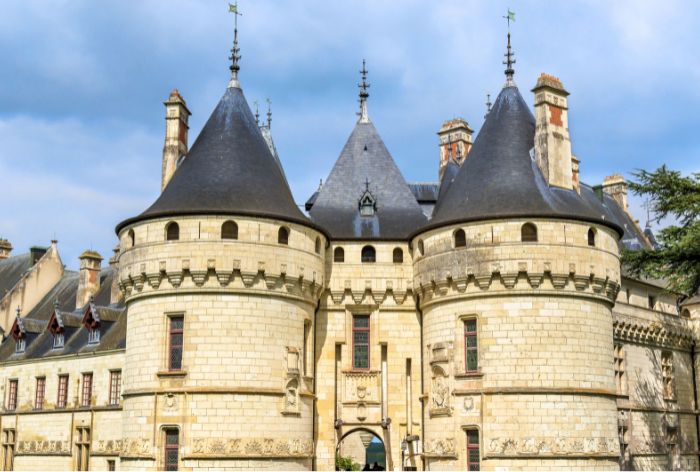
Château de Chaumont-Sur-Loire / to See at Château de Chaumont-Sur-Loire
The late 19th-century updates are also visible today, with modern amenities like electricity and central heating added by architect Paul-Ernest Sanson.
The stables, which were expanded during this time, are a perfect example of how the château was transformed into a luxurious residence.
Now, the château is a fascinating mix of old and new, offering a unique experience of French history and architectural beauty.
The Ruggieri Room
One of the rooms that really stands out is the Ruggieri Room.
The fireplace features a unique symbol—a triangle and three circles—that has sparked quite a bit of discussion over the years.
Some believe it’s a reference to Cosimo Ruggieri, Catherine de Medici’s astrologer, while others think it could be linked to Diane de Poitiers and the Roman goddess of the moon. Whatever the meaning, it definitely adds an air of mystery to the room.
Cosimo Ruggieri wasn’t just any astrologer—he had a significant influence at the French court, particularly with Catherine de Medici, who relied on his advice for everything from personal matters to political decisions.
He was involved in key events of the time, including the St. Bartholomew’s Day Massacre, and his presence in the court left a lasting imprint on history. The symbol in the Ruggieri Room could very well be a subtle nod to his influence.
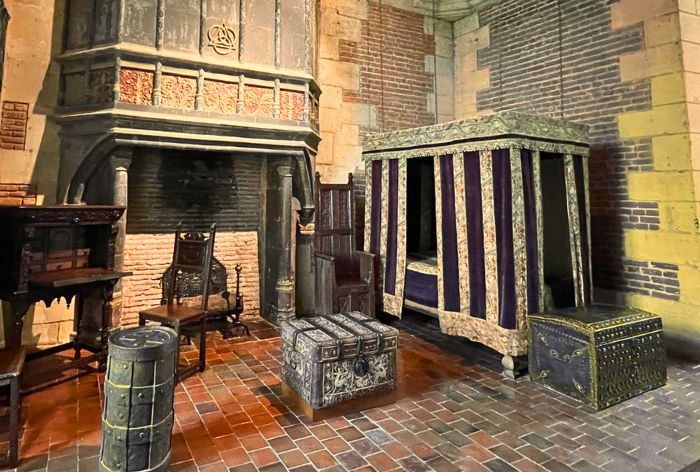
The Ruggieri Room / What to See at Château de Chaumont-sur-Loire
The room itself is full of fascinating pieces!
You’ll notice a 17th-century four-poster bed, and a portrait that some believe might be of Ruggieri himself. There’s also a medieval throne with tiered seating, reflecting the social hierarchy of the time.
And a clever 17th-century cabinet with hidden compartments—just one of those little details that shows how people loved their secrets back then.
Look up, and you’ll see a beautifully painted fireplace from the 1500s, giving a glimpse into the colorful, lively décor of the past. The mix of brick and stone walls shows off the Renaissance building style, giving the room a timeless feel.
The Catherine de Medici Room
The Catherine de Medici Room is named after the queen who took over the château in 1550, and it’s easy to see how it reflects her style and the grandeur of the time.
This room wasn’t just for show—it was once a bustling space for everything from meals to big receptions. You’ll find a stunning 15th-century tapestry here, “The Story of Perseus and Pegasus,” which is beautifully woven and captures the dramatic stories of the era.
There’s also a 19th-century recreation of Catherine’s portrait, bringing her legacy into the room in a very personal way.
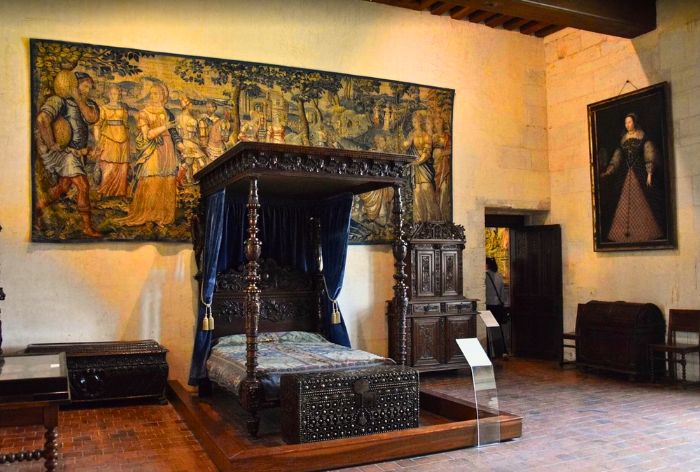
The Catherine de Medici Room / What to See at Château de Chaumout-sur-Loire
The room is full of eye-catching pieces, like an intricately carved Henri II-style bed that takes center stage. There’s also a throne and a wardrobe with some really detailed carvings symbolizing virtues and the changing seasons.
But one of the coolest things to check out is the collection of medallions by Jean-Baptiste Nini. These medallions feature portraits of famous figures like Louis XV and even Benjamin Franklin—talk about a quirky mix of history right here in the château!
The Council Chamber
The Council Chamber is where some of the château’s biggest moments took place—think grand feasts, important decisions, and official gatherings.
To really bring out its significance, the de Broglie family gave the room a thoughtful update, adding benches along the walls and a stunning painted ceiling featuring their family crest and initials mixed into floral designs.
Take a moment to look down, and you’ll see the intricate Majolica tiles on the floor. They’re so detailed, they almost feel like their own piece of art.
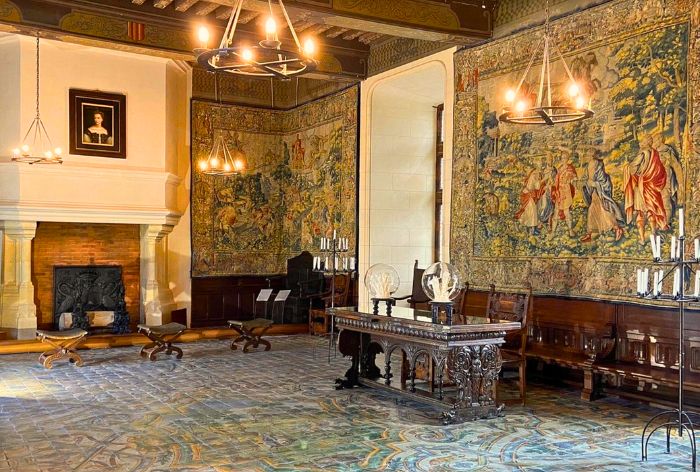
The Council Chamber / What to See at Château de Chaumont-sur-Loire
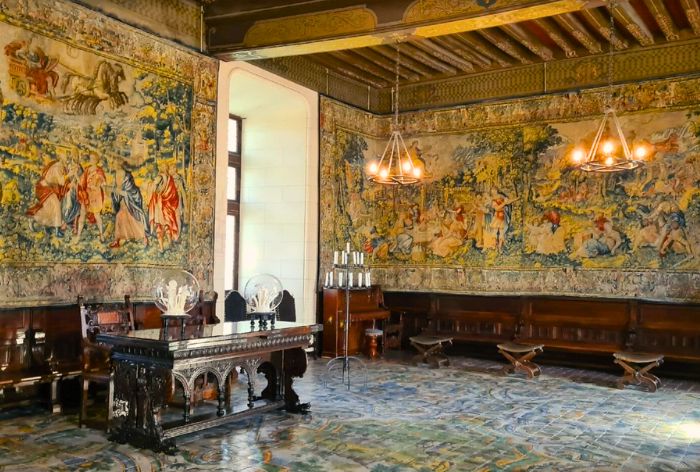
The Council Chamber / What to See at Château de Chaumont-sur-Loire
The Guard Room
The Guard Room played a key role in the château’s defense back in the 16th century. It wasn’t just a hallway leading to the parade room—it was where guards trained and kept a close watch over the grounds and drawbridge from a strategic window. This was the place that helped protect the château from any threats.
Today, the room is full of history, with a fascinating collection of weapons and armor from different eras. Above the fireplace, you’ll spot Ottoman shields and helmets, which were gifts from the Maharaja of Kapurthala to the Prince de Broglie.
And here’s a fun twist—the Princess didn’t just get gifts of armor; she also received a pet elephant named Miss Pundji!
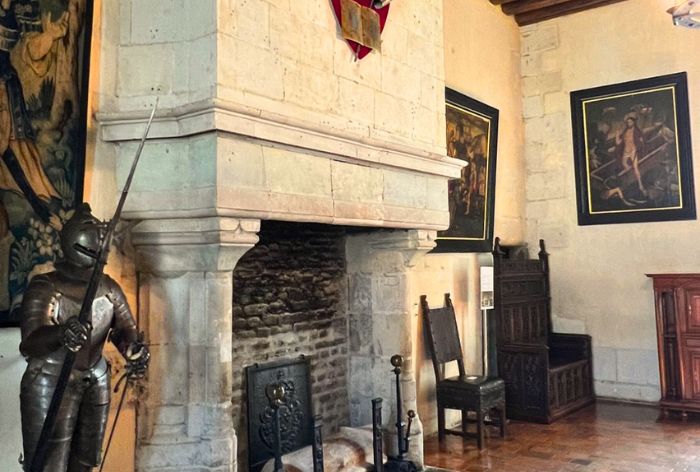
The Guard Room / What to See at Château de Chaumont-sur-Loire
The King's Room
The King’s Room got its name in honor of Louis XII, who visited the château in 1503.
By the 19th century, it was transformed into a study for Prince Henri-Amédée de Broglie, where he took care of estate matters. It’s a fascinating mix of furniture from different styles and time periods, making it feel like a blend of history.
One of the standout pieces is the striking black wood bookcase and work cabinet with intricate bone inlay, both on loan from the Mobilier National.
The room’s colorful wall and ceiling designs from the 1850s really add to the vibe, with symbols and initials that tie the château’s past owners together—like the Medici family’s initials intertwined with those of the de Broglies.
The Spiral Grand Staircase
The Spiral Grand Staircase at Chaumont is one of those features that just takes your breath away.
Built in the 1500s, when staircases were more than just functional. They were a symbol of prestige.
Originally open and airy, it’s changed a bit over the years with renovations, but it still has that wow factor. The staircase blends Gothic and Renaissance styles, with intricate carvings of leaves and shells decorating the central column, adding to its charm.
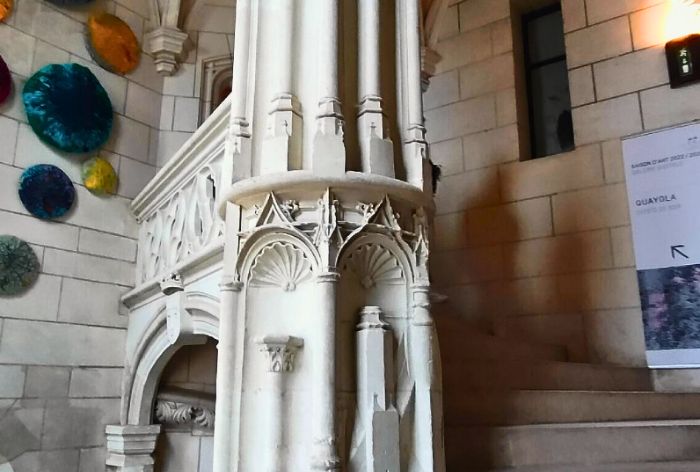
The Staircase / What to See at Château de Chaumont-sur-Loire
The Chapel
The Chapel, located at the far end of the East Wing, was built between 1498 and 1511 under Charles II de Chaumont-Amboise during King Louis XII’s reign. It features a small transept and a three-sided apse, with large crown windows that flood the space with light, creating a serene atmosphere.
Take a moment to admire the intricate details: twisted columns adorned with delicate arabesques and shells, and a 16th-century frieze reminiscent of the Saint Hubert chapel in Amboise.
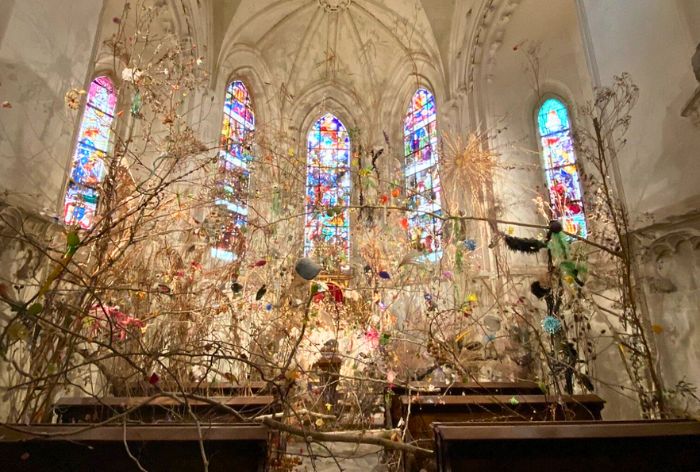
The Chapel / What to See at Château de Chaumont-sur-Loire
The Private Apartments
The Private Apartments on the ground floor of the south and west wings were completely revamped in the late 19th century by architect Paul-Ernest Sanson, who Prince and Princess de Broglie hired.
Sanson added a lot of modern comforts for the time, like electricity, central heating, and running water—pretty impressive upgrades back then!
Thanks to some careful restoration work, which included digging through historical records and old photos, the Great Salon, Library, and Dining Room have been beautifully brought back to life.
These rooms now feature some of the finest furnishings in the Loire Valley, giving you a real sense of what life was like for the château’s 19th-century residents.
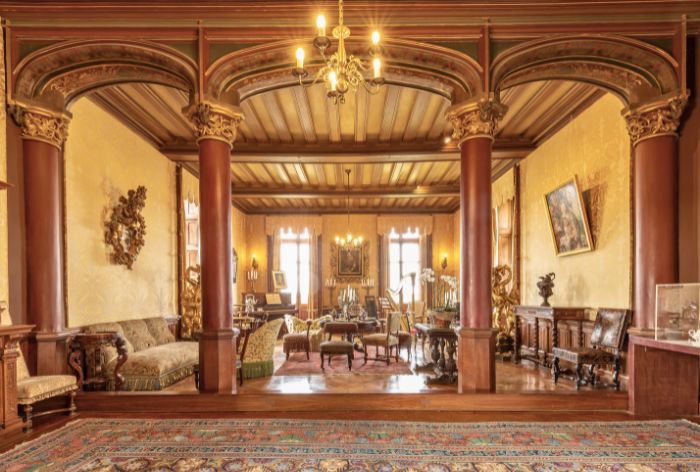
The Private Apartments / What to See at Château de Chaumont-sur-Loire
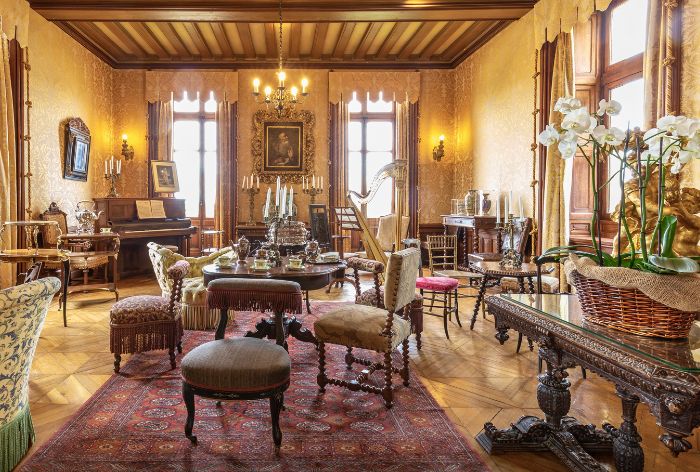
The Private Apartments / What to See at Château de Chaumont-sur-Loire
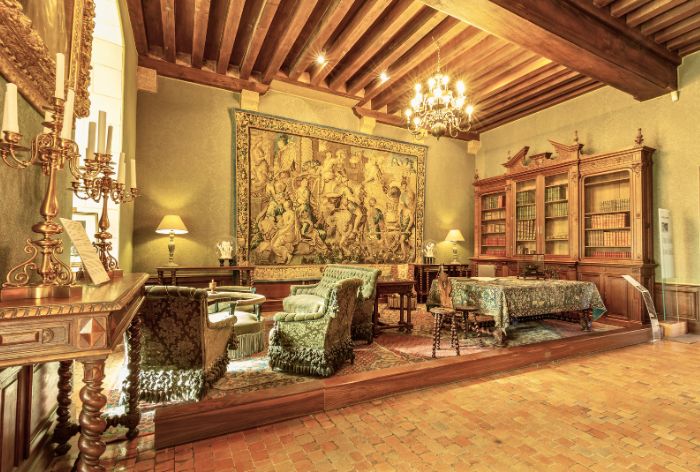
The Private Apartments / What to See at Château de Chaumont-sur-Loire
Chaumont's Grounds
The grounds at Chaumont are a more recent addition compared to the château itself.
Back in the 1880s, landscape architect Henri Duchêne transformed the property into beautiful English-style gardens, meant to be a relaxing, leisure space. By 1888, these elegant grounds finally gave the château the grand setting it had always deserved.
As you wander through, you’ll spot some quirky touches, like a rustic bridge, a water tower cleverly disguised as a reservoir, and even a dog cemetery—just a few things that give the park its unique charm.
The Stables at Chaumont
The stables at Chaumont are a real nod to the 19th-century obsession with horses and all things grand.
Built in 1877 by architect Paul-Ernest Sanson, they were designed to be the most luxurious and modern stables in all of Europe.
Made from brick and stone, they feature decorative elements pulled right from the château itself, like sculpted friezes with the monogram of Charles II de Chaumont and the famous flaming mountain symbol.
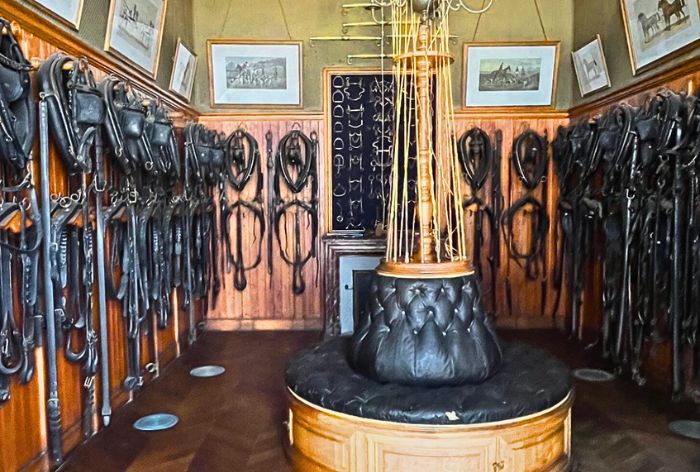
The Stables / What to See at Château de Chaumont-sur-Loire
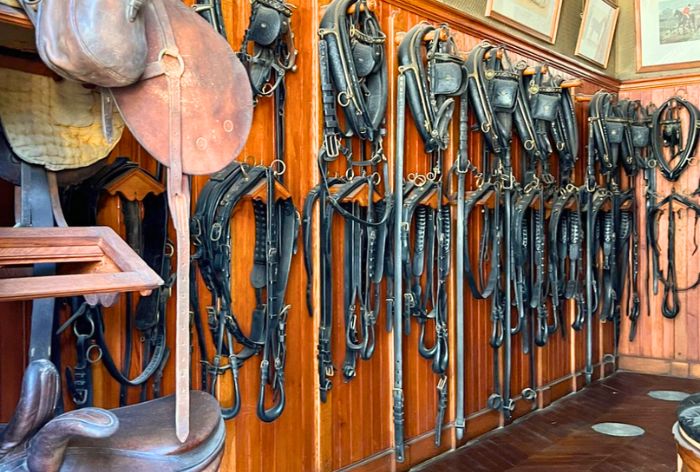
The Stables / What to See at Château de Chaumont-sur-Loire
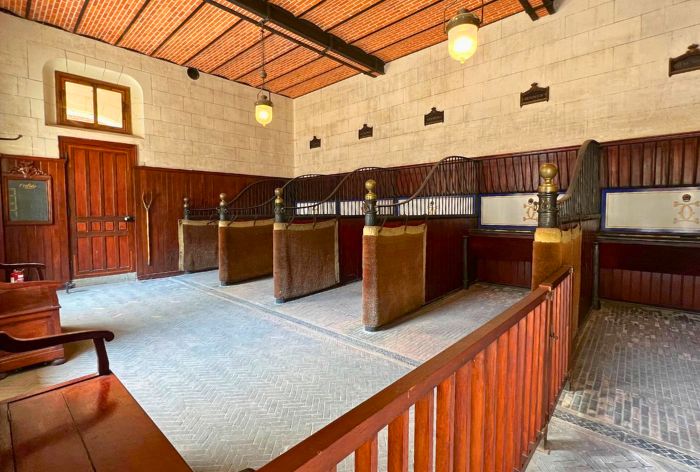
The Stables / What to See at Château de Chaumont-sur-Loire
International Garden Festival
The International Garden Festival at Château de Chaumont-sur-Loire is one of those events that really makes you see gardens in a whole new light.
Held every year since 1992, this festival brings together artists, landscape designers, and architects from all over the world to create one-of-a-kind garden displays that push the boundaries of creativity and nature.
Each year, the festival has a different theme, and that’s what makes it so exciting. The gardens are all temporary, designed to reflect whatever the theme is, offering fresh and imaginative takes on what a garden can be.
Past themes have included “Flower Power” and “Jardins de la pensée,” so there’s always something new and thought-provoking to see.
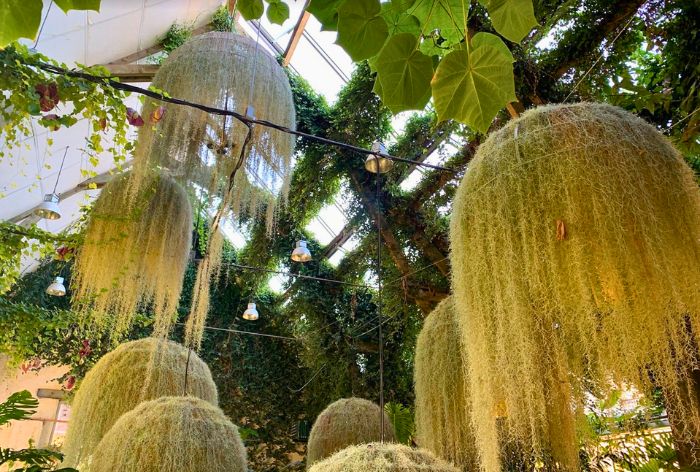
The International Garden Festival / What to See at Château de Chaumont-sur-Loire
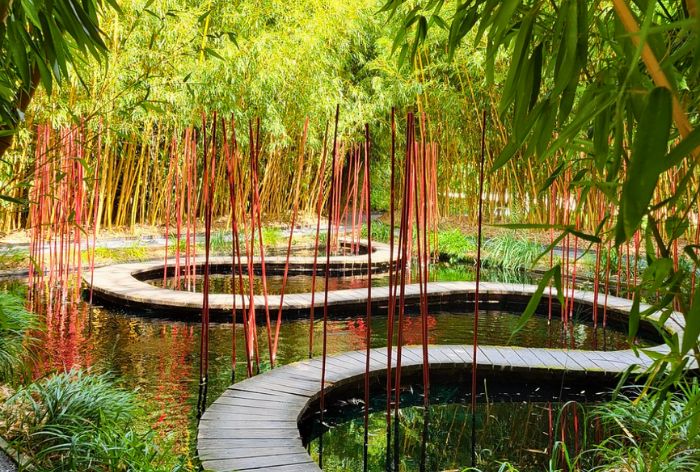
The International Garden Festival / What to See at Château de Chaumont-sur-Loire
One of the most magical experiences is visiting the gardens at night, especially during the “Jardins de Lumière” (Gardens of Light) from July to August. The gardens are illuminated with soft lights, vibrant colors, and ambient sounds, making it feel like you’re walking through a dream. It’s an enchanting way to see the creative designs in a whole new light—literally!
Practical Tips for Visiting Château de Chaumont-sur-Loire
Getting to Château de Chaumont-sur-Loire
Château de Chaumont-sur-Loire sits right in the heart of the Loire Valley, perfectly perched above the Loire River between Blois and Amboise. It’s an easy spot to reach, and getting there is half the fun!
By Car:
If you’re driving from Paris, it’s about 185 km, so plan for a little over two hours. Hop on the A10 motorway heading toward Bordeaux, take Exit 17 at Blois, and then follow the D952 and D751 roads for about 30 minutes. The château has free parking, and if you’re traveling with a stroller or have mobility concerns, they’ve got you covered with priority spaces.
By Train:
Prefer the train? The closest station is Onzain, just 2.5 km from the château. You can catch a quick ride from Blois to Onzain—it’s only 8 to 12 minutes. Once you’re there, you’ve got options: take a pleasant walk across the Loire River to the château or grab a taxi if you’re looking to save time (or energy!).For visitors arriving by train, the Onzain – Chaumont-sur-Loire station is the nearest stop, with trains running daily. From the station, it’s approximately a 45-minute walk to the estate, or you can take a bus or taxi for convenience.
Tickets and Opening Times
When you visit Château de Chaumont-sur-Loire, you can explore its stunning architecture, gardens, and history throughout the year. The château is open every day, though hours vary by season. In the summer months, you can visit from 10:00 a.m. to 7:00 p.m., and during the winter, it’s open until 5:30 p.m. The gardens are also a highlight, with the International Garden Festival bringing a new theme each year, adding a unique experience depending on when you visit.
Ticket prices for adults are €21 during peak season, but there are reduced rates for children and students. Children under 5 can visit for free, which makes it a great family outing. If you want to skip the lines and guarantee entry, you can buy your tickets online in advance here.
Where to Eat at Château de Chaumont-sur-Loire
If you’re spending a good part of the day at Chaumont, you’ll definitely want to take a break and enjoy something to eat—and the estate has a couple of lovely spots to choose from.
Le Grand Chaume is a real treat. It’s not your typical château restaurant—it feels warm and welcoming with its timber beams and thatched roof, but it still has a modern, airy feel thanks to the big windows that overlook the terrace and a quiet little pond. The food is seasonal and fresh, with ingredients sourced from the Loire Valley.
If you’d rather keep things simple, Le Café des Savoirs et des Saveurs is a great option. It’s laid-back and easy, perfect for grabbing a snack or a light bite before heading back out to explore the grounds.
How Much Time Is Needed
To fully soak in the château’s history, explore its beautiful grounds, and take in the International Garden Festival, plan to spend about 3 to 4 hours at Domaine de Chaumont-sur-Loire.
Arrive early when the estate opens to enjoy a peaceful start to your day. Begin by taking a self-guided tour through the château.
Afterward, head out to the gardens, where you can explore the creative displays of the International Garden Festival.
Afterward, be sure to visit the stables and farm to learn about the estate’s agricultural history.
Here Are Some More Ideas of Places to Visit in France:
How to Visit Fontainebleau on a Day Trip from Paris (13 Best Things You Can’t Miss)
What to See at Château d’Azay-le-Rideau (12 Things You Can’t Miss + Practical Tips for Your Visit)
13 Tips for First Visit to Rouen to Help You Explore the CityWhat to See at Château de Villandry (13 Things You Can’t Miss + Practical Tips)
DIY Walking Tour of Rouen (17 Best Stops, Map and Tips)
What to See at Château de Chaumont-sur-Loire (12 Things You Can’t Miss + Useful Tips)
What to See at Château de Chenonceau (14 Things You Can’t Miss+Useful Tips for Your Visit)
What to See at Château d’Amboise (10 Things You Can’t Miss + Useful Tips for Your Visit)
How to Spend 6 Days in the Loire Valley (Detailed Itinerary + Practical Travel Tips)
7 Must-See Châteaux in the Loire Valley for First-Time Visitors (What to See + Practical Tips)
Did You Find It Useful? Why Not Save What to See at Château de Chaumont-sur-Loire to Pinterest!


Now, It Is Your Turn, I Would Like to Hear Back from You!
Are you planning your trip to France?
Please let me know! Drop me a quick comment right below!
Click on any of the images below to get inspired and to help you with the planning process for your trip to France!
